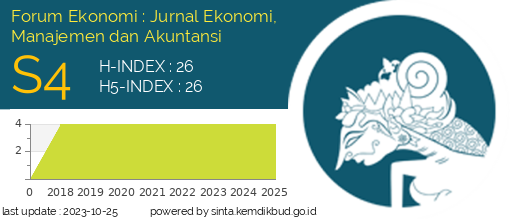Determinants of Macroeconomic Variables and HDI on Indonesia's GDP Using the ARDL Method
DOI:
https://doi.org/10.30872/jfor.v27i1/3538Keywords:
Gross Domestic Product, Household Consumption, Investment, Economic Openness, Human Development IndexAbstract
The successful performance of economic development is calculated by constant price economic growth or real Gross Domestic Product (GDP). Indonesia's GDP value from 1990-2021 tends to increase, but its growth fluctuates. This study aims to analyze the effect of macroeconomic variables including household consumption, foreign investment, domestic investment, economic openness and the Human Development Index (HDI) on Indonesia's GDP in the short and long term 1990-2021. The analysis technique uses Autoregressive Distributed Lag (ARDL). Analysis through the EViews application results: 1). In the short term, the consumption variable has a positive impact on Indonesia's GDP. Foreign investment, on the other hand, has a negative impact. Domestic investment shows a significant positive effect, while economic openness has a significant negative effect on GDP. Additionally, the Human Development Index (HDI) variable demonstrates a significant negative impact on Indonesia's GDP in the short term.; 2). Looking at the long term, only the HDI variable exhibits a significant positive effect on Indonesia's GDP. The implications of increasing GDP and economic growth, leading to higher consumption in society in the short term, necessitate the implementation of policies aimed at improving the wage system and social security. Moreover, attracting foreign investment becomes crucial in sectors where the government and domestic investors cannot operate effectively. For domestic investment, it is essential to deregulate investment arrangements and encourage more proactive investment services to support increased productivity and meet domestic needs. Economic openness can be achieved by boosting exports of finished goods rather than raw materials. Simultaneously, efforts to improve the Human Development Index (HDI) must be evenly distributed both in the short and long term
References
Al Rasasi, M., Alzahrani, Y., & Alassaf, M. (2021). On the Causal Relationship between Household Consumption and Economic Growth in Saudi Arabia. Business and Economic Research, 11(2), 165–177. https://doi.org/https://doi.org/10.5296/ber.v11i2.18386
Alvarado, R., Iñiguez, M., & Ponce, P. (2017). Foreign direct investment and economic growth in Latin America. Economic Analysis and Policy, 56, 176–187. https://doi.org/https://doi.org/10.1016/j.eap.2017.09.006
Anyanwu, C. J. (2014). Factors Affecting Economic Growth in Africa : Are There any Lessons from China. African Development Review, 26(3), 468–493.
Azwar, A. (2016). Peran Alokatif Pemerintah melalui Pengadaan Barang/Jasa dan Pengaruhnya Terhadap Perekonomian Indonesia. Kajian Ekonomi Dan Keuangan, 20(2), 149–167. https://doi.org/https://doi.org/10.31685/kek.v20i2.186
Bayar, Y. (2016). Impact of Openness and Economic Freedom on Economic Growth in the Transition Economies of the European Union. Europe Journal of Economics, 1, 7–19.
BPHN. (2016). NA RUU Lembaga Pembiayaan Pembangunan Indonesia. https://bphn.go.id/data/documents/na_ruu_lembaga_pembiayaan_pembangunan_indonesia.pdf
BPS. (2021). Indeks Pembangunan Manusia 2020.
Dewi, N. L. S., & Sutrisna, I. K. (2014). Pengaruh Komponen Indeks Pembangunan Manusia Terhadap Pertumbuhan Ekonomi Provinsi Bali. E-Jurnal EP Unud, 3(3), 106–114.
Ekananda, M. (2016). Analisis Ekonometrika Time Series (Kedua). Mitra Wacana Media.
Elistia, E., & Syahzuni, B. A. (2018). The correlation of the human development index (HDI) towards economic growth (GDP per capita) in 10 ASEAN member countries. Jhss (Journal of Humanities and Social Studies), 2(2), 40–46.
Fitriani, S. A., & Hakim, D. B. (2021). Analisis Kointegrasi Keterbukaan Perdagangan dan Pertumbuhan Ekonomi Di Indonesia (Cointegration Analysis of Trade Openness and Economic Growth in Indonesia) bagi hampir seluruh negara di dunia. Kemajuan Sarana Interpendensi Kegiatan Perekonomian, 12(2), 103–116. https://doi.org/https://doi.org/10.22212/jekp.v12i1.2033
Ghozali, I. (2009). Ekonometrika Teori, Konsep dan Aplikasi dengan SPSS 17. Badan Penerbit Universitas Diponegoro.
Gujarati, D. N., & Porter, D. C. (2013). Basic Econometrics (Kelima). Douglas Reiner.
Handriyani, R., Sahyar, M. M., & Arwansyah, M. (2018). Analysis the Effect of Household Consumption Expenditure, Investment and Labor to Economic Growth: A Case in Province of North Sumatra. Studia Universitatis „Vasile Goldis” Arad – Economics Series, 28(4), 45–54. https://doi.org/https://doi.org/10.2478/sues-2018-0019
Kambono, H., & Marpaung, E. I. (2020). Pengaruh Investasi Asing dan Investasi Dalam Negeri Terhadap Perekonomian Indonesia. Jurnal Akuntansi Maranatha, 12(1), 137–145. https://doi.org/https://doi.org/10.28932/jam.v12i1.2282
Mahriza, T., & Amar B, S. (2019). Pengaruh Investasi Dalam Negeri, Investasi Asing, Tenaga Kerja Dan Infrastruktur Terhadap Perekonomian Di Provinsi Sumatera Barat. Jurnal Kajian Ekonomi Dan Pembangunan, 1(3), 691–704. https://doi.org/https://doi.org/10.24036/jkep.v1i3.7697
Nuraini, R., & Mudakir, B. (2019). Analisis Pengaruh Keterbukaan Ekonomi Terhadap Pertumbuhan Ekonomi (Studi Kasus: Asean Tahun 2007 – 2017). Jurnal Dinamika Ekonomi Pembangunan, 2(2), 20. https://doi.org/https://doi.org/10.14710/jdep.2.2.20-35
Sani, R. M., Sambodo, H., & Bambang, B. (2018). he Effect of Human Capital, Labors, and Capital on Economic Growth in Barlingmascakeb. Eko-Regional Jurnal Pengembangan Ekonomi Wilayah, 13(2), 60–68. https://doi.org/https://doi.org/10.20884/1.erjpe.2018.13.2.1172
Saqib, N., Masnoon, M., & Rafique, N. (2013). mpact of Foreign Direct Investment on Economic Growth of Pakistan. Advances in Management & Applied Economics, 3(1), 35–45.
Sudirman, S., & Alhudhori, M. (2018). Pengaruh Konsumsi Rumah Tangga, Investasi Terhadap Pertumbuhan Ekonomi Di Provinsi Jambi. EKONOMIS : Journal of Economics and Business, 2(1), 81–91. https://doi.org/https://doi.org/10.33087/ekonomis.v2i1.33
Sukirno, S. (2019). Makroekonomi Teori Pengantar (Ketiga). PT RajaGrafindo Persada.
Susanto, A. B., & Rachmawati, L. (2013). Pengaruh Indeks Pembangunan (IPM) dan Inflasi Terhadap Pertumbuhan Ekonomi Di Kabupaten Lamongan. Jurnal Ekonomi Unesa, 1(3), 6–24.
Tapparan, S. R. (2020). Analisis Pengaruh Pengeluaran Konsumsi Rumah Tangga Dan Pengeluaran Pemerintah Terhadap Pertumbuhan Ekonomi Tana Toraja. Journal Ekonomika Lidikti, 4(2), 12–18. http://journal.lldikti9.id/Ekonomika
Todaro, M. P., & Smith, S. C. (2006). Pembangunan Ekonomi (D. Barnadi & W. Hardani (eds.); Kesembilan). Erlangga.
Downloads
Published
Issue
Section
License
Copyright (c) 2025 Wine Diwani, Dijan Rahajuni, Herman Sambodo, Putri Purwaningtyas

This work is licensed under a Creative Commons Attribution-ShareAlike 4.0 International License.






